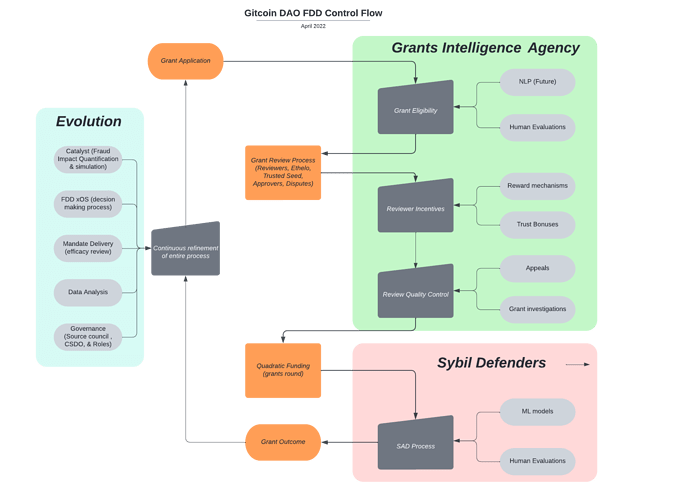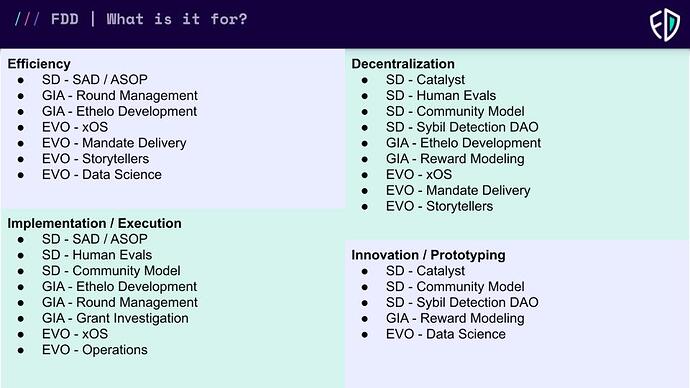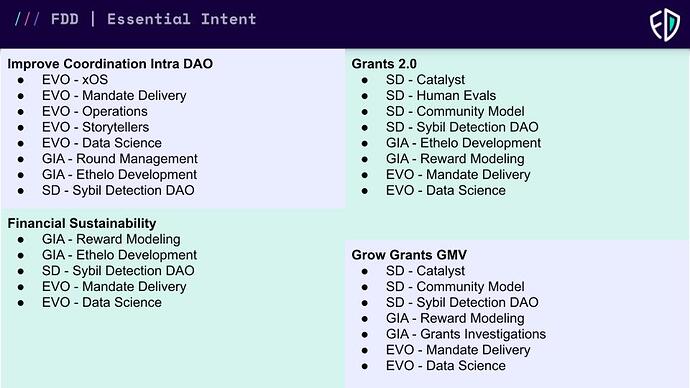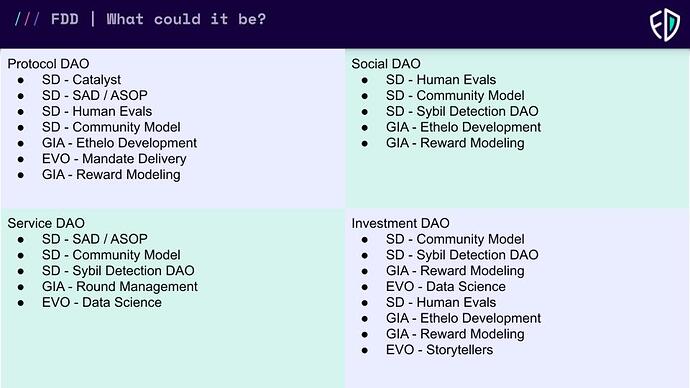Hey friends on GitcoinDAO 
Sorry for the late comment. I’ll express my contribution which will make the case towards us exploring what it takes to push for more evolution and how this passes through sketching how a Sybil Detection DAO could look like, as we can and should perform incentive alignment around our ultimate goal of providing Web3’s best Sybil Detection as a Service.
Most of the current function as well as some challenges of FDD has been described in the discussion here. FDD performs a critical function in GitcoinDAO, as Sybil Resistance and Collusion Resistance are critical for the legitimacy of Grants.
This is done through a series of increasingly sophisticated processes that have been developed by the entire FDD group since before the DAO was created, and required because our ecosystem demands ever increasing technical excellence with no compromises whatsoever on transparency, decentralization and community ownership on the input, process and outcome. It has been a process of pioneering both in how we organize (governance of algorithmic processes - i.e. the machine learning pipeline), and how we detect and defend against sybil attacks and collusion (governance by algorithms, in a DAO).
Going deep and evolving this critical function is not easy nor trivial, and it can be far from sexy when scratching the surface of what it should be. After all, it is about the ongoing operation and maintenance of GitcoinDAO as infrastructure. It also requires domain expertise to develop, operate, iterate on, and maintain the machine learning sybil detection pipeline.
Additionally, FDD has arguably managed to create one of the most distinctive initiatives on Web3 so far in terms of real-world Sybil Account Detection - one of the space’s biggest challenges, especially where quadratic voting is employed. The unique blend of experts together with the holistic / integrated processes that were battle-tested on one of the Web3 mostly used platforms is certainly something to be proud of. Something that can also be leveraged and used by all value-aligned platforms on which their success depends on reaching out to real users without compromising on their privacy or incentive alignments.
Given the above considerations, it can be helpful to also share some thinking about what can be a possible strategic direction and a proposal for next steps.
We want to ensure FDD and GitcoinDAO have incentive alignment AND functional alignment to defend against sybils. I have written a tale below that provides an analogy for what is functional alignment in this case.
We think it could be possible for FDD to evolve further from a GitcoinDAO core team, to become its own DAO that is a service provider to Gitcoin, and potentially other DAOs. FDD is a critical function for DAO maintenance (especially with Quadratic Voting), but it also may likely be a useful service to other DAOs, which would reduce cost dependencies on GitcoinDAO.
This being true, then it could be the best long-term sustainable path by both improving the sybil detection (through bi-directional interface points with other data partners) and reducing the cost to GitcoinDAO as various ecosystem partners will be involved in the usage and cost sharing on this new Sybil Detection DAO.
The next step is to Explore. To sketch how it could look like and to map its limitations and opportunities. To discuss as much as possible while there aren’t points of no return. To have a document which allows the community at large to constructively criticize and reject in detail or in its whole form. This is the core intent and function of the SDD work-stream, and it is expected to take the following form:
- Deliverable: A written briefing report that includes:
- Definition of a clear purpose and functional remit for SDD
- Diagrams/sketches of potential SDD token governance and economic systems
- Summary of the results of discussions with potential data partners and scoping of bi-directional interface points
- Description of a technical roadmap for making SDD viable
- Recommended next steps
- Method: a 3-phase process, on which:
- Phase 1: Freestyle sketching
- A strawman sketch will be produced based on the combined knowledge of how the SDD + ecosystem tech & dynamics is playing right now.
- Phase 2: Intense Iterations
- The strawman sketch will pass through extensive review from SMEs to ensure that its cohesive and viable
- Phase 3: Polish & Communicate
- The iterated document will be transformed and published into an form that invites public-facing iterations & criticisms
I hope these thoughts help share the broader context going into this function, its value to GitcoinDAO and the broader ecosystem, and the potential strategic direction.
Extra: The Tale of the Decentralized Common Goods Factory and its own Sybil Detection Generator
(If is too wacky, replace DCG Factory → Factory, and Sybil Detection → Electricity)
Let’s imagine a fictitious factory. The Decentralized Common Goods (DCG) Factory, which is owned and managed by the diligent Quadratic Bot, which concerns itself only with maximizing the quality and the positive externalities of what’s being produced.
Quadratic Bot knows that the DCG Factory consumes a lot of Sybil Detection energy, and in order to have consistent production results, he decides to purchase and operate its own Sybil Detection Generator, which provides this critical piece of infrastructure to the factory to be autonomous.
At some point in time, Quadratic Bot decides that the factory should be less monolithic and that its core functions should be more decentralized and autonomous. As a result of that, the Sybil Detection Generator now has its own manager: Not-Sybil.
Not-Sybil, which is as diligent as Quadratic Bot, also only concerns himself with the quality and the positive externalities of what’s produced too. The product in this case is delivering the best Sybil Detection to his users.
As the DCG Factory is decentralized and open-source, the commoners of the local village quickly take notice of all the innovation happening inside it, including the Sybil Detection Generator, which is tailored end-to-end for being as optimal as possible for its function.
Not-Sybil, observing the demand for Sybil Detection and taking in mind his mission of maximizing positive externalities, decides that it can be a good idea to expand the Sybil Detection Generator capacity and technology for more deeply integrating with the community demands.
Quadratic Bot is enthusiastic, but this capacity is way more than he needs, and it is not obvious how the payoff is going to be in terms of the quality improval on the factory products. It may even be a distraction.
Quadratic Bot and Not-Sybil are intertwined in a dilemma. There are no questions about the history and the ownership: it was Quadratic Bot who bought and took the risk for the Sybil Detection Ownership. But now that it is being managed by Not-Sybil, the goals are different. Quadratic Bot wants the generator to provide critical services. Not-Sybil wants the generator to provide the best services.
How do we untangle that? One option is to re-absorb the Sybil Detection Generator under the Quadratic Bot guidance and dismiss / re-educate Not-Sybil. Make it provide the critical service again.
Another one is to imagine a future where the Sybil Detection Generator becomes its own autonomous organization. On which Sybil Detection is also a decentralized common good product too, which is used as a critical service by multiple villages and projects.
The future is uncertain and risky. Discovering and mapping it beforehand, and making explicit the landmarks and obstacles can allow for us to have a grasp of the journey without taking points of no return.





